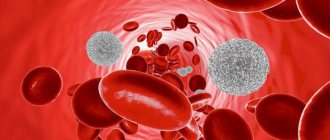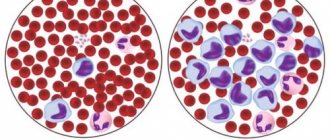0
Author of the article: Marina Dmitrievna
2017.08.22
691
Leukocytes
During pregnancy, women regularly donate blood for analysis, which makes it possible to identify abnormalities in the composition of the blood, since they can have dangerous consequences for both the female body and the fetus. Violation of the level of leukocytes is considered an indicator of abnormal phenomena in the body and the development of diseases.
Leukocytes
The level of leukocytes, which act as a protective barrier for a pregnant woman and child, is also under constant monitoring by doctors. These cells resist viruses, pathogenic bacteria and allergens that have entered the body, the development of inflammatory reactions, and strengthen the immune cellular system. The main proportion of leukocytes are segmented neutrophils.
Condition monitoring during pregnancy
For the normal course of pregnancy at all stages, it is necessary to promptly monitor the woman’s condition. Immediately after registration, the frequency of observation is agreed upon. In this case, you not only need to be examined by a gynecologist during certain weeks of pregnancy, but also undergo a minimum amount of mandatory laboratory tests. These include:
- general clinical blood test (CBC);
- general urine analysis;
- vaginal smear analysis.
The results of these simple studies make it possible to identify the emerging pathology in its early stages and treat it in a timely manner in order to avoid further serious complications for the mother and child.
Methods for normalizing an indicator
To avoid fluctuations in white blood cell counts, a pregnant woman needs to lead a correct and measured lifestyle, eat frequently and in small portions, eat high-quality and healthy food, try to protect herself from all kinds of stressful situations and anxiety, not overwork, but maintain normal physical activity.
Communication should be kept to a minimum; in public places, especially when there is a threat of mass epidemics, wear a mask and spend more time in clean fresh air. Hygienic measures and regular ventilation, a supportive and calm environment in the family will help make the pregnant woman’s health strong and protect her from physiological surges in leukocyte counts.
If the analysis reveals a pathological change in the level of cells, it is necessary to make a decision as quickly as possible on adequate treatment that will eliminate the cause of leukopenia or leukocytosis and will not affect the health and well-being of the mother and unborn child.
Read: Causes of low white blood cell levels, treatment and complications
Leukocytes – the body’s immune defense
Leukocytes are cells belonging to the body's immune system, part of its immune defense. When an infectious agent of any nature enters the human body or the body of a pregnant woman, protective reactions are activated. The number of leukocytes in the blood increases (leukocytosis). The increased indicator itself only indicates that some kind of inflammation has arisen.
What caused the inflammatory reaction, what pathogen became the source of the pathological condition and what system or organ is involved in the disease process must be clarified by studying the results of additional studies.
In a general blood test, in addition to elevated leukocytes, there may be a high ESR - erythrocyte sedimentation rate, which is also an indirect general indicator of the inflammatory process. Lymphocytes, monocytes, and granulocytes may also deviate from the norm. These are types of white blood cells, each of which plays an important role in inflammation.
Why is leukocytosis dangerous in an expectant mother?
A pregnant woman donates blood for testing every month. When the level of leukocytes jumped above 12-15 thousand per cubic meter. mm, a woman comes for analysis once every two weeks. The doctor’s task is to find out the cause of the disorder; the woman is sent for additional diagnostics.
If the reason is in physiology
Leukocytosis can be temporary, occurring as a reaction to negative environmental factors or natural processes in the body. In such a situation, high leukocyte counts do not indicate the development of pathologies, and the level of white cells returns to normal after the cause of the jump is eliminated. Among the physiological reasons:
- hypothermia of the body - for example, as a result of walking in the rain or in the cold;
- overheating of the body - for example, from a long stay in a hot bath or under hot shower jets;
- lack of vitamin-rich foods in a woman’s daily menu; food with an abundance of carbohydrates is a priority;
Excessive love of sweets increases the number of leukocytes in the blood - heavy physical activity;
- imbalance of hormones, as a result - thickening of the blood;
- nervous excitement leading to stress;
- severe toxicosis.
If a blood test shows an increase in leukocytes, a repeat procedure is required. With leukocytosis due to physiological reasons, the indicators will most likely return to normal. But when there are more and more white cells, the doctor suspects diseases of the internal organs.
Pathological causes of leukocytosis
If a woman suffered from chronic diseases before pregnancy, the pathologies tend to worsen during pregnancy. This means that the number of leukocytes in the blood increases, because the body needs help in fighting the disease.
Similarly, a regiment of leukocytes arrives when a pregnant woman:
- infectious infections caused by bacteria or viruses - pneumonia, chickenpox, hepatitis, intestinal infections; this also includes inflammation of the genitourinary system - cystitis, urethritis;
- purulent inflammations, including sepsis (spread of infection through blood), abscess (appearance of purulent cavities in organs);
- due to allergies, the respiratory tract is inflamed, there is a threat of anaphylactic shock; allergic reactions occur even in pregnant women who have never encountered them before - food, animal hair, household chemicals, and medications act as “provocateurs”;
- internal bleeding or significant blood loss due to an open wound;
- liver diseases;
- thrush;
- cancer tumor.
Sometimes such a pathology occurs: a woman’s bone marrow suddenly begins to release increased portions of leukocytes into the blood. In some cases, the disease goes away without medical intervention, but sometimes it develops - then doctors diagnose hyperleukocytosis. Pathology can disrupt the functioning of many organs and systems.
A malignant neoplasm in the bone marrow leads to damage to the hematopoietic system, which is called leukemia (or leukemia). Rarely, the disease occurs in pregnant women with chromosomal abnormalities; then the number of white cells jumps to 40–80 thousand. Timely therapy will help the unborn child to be born healthy; Mom will have to be treated for leukemia after childbirth.
Consequences for the woman and fetus
Leukocytosis caused by pathological causes is a symptom of severe disorders in the body; Without surgical treatment of diseases that result in increased leukocytes, a woman will endanger both her own life and the life of her child. The same sepsis or suffocation from allergies are deadly.
When pathogenic microbes take over the body of a pregnant woman, the fetus risks:
- get intrauterine growth retardation;
- be born with birth defects;
- die in the womb from oxygen starvation - hypoxia.
Leukocytosis causes internal bleeding, which also threatens the baby's life.
In some situations, the doctor insists on terminating pregnancy, which becomes fatal for the woman.
Norm of leukocytes in the blood
For women, the norm for leukocytes is 4-9 g/l. Depending on the condition (stress, physical and emotional stress, heavy food - 3-4 hours after eating, exposure to external conditions - overheating or hypothermia), the numbers of leukocytes in the blood may change: increase by insignificant amounts within the limits of the specified norm.
Therefore, OKA should be taken in the morning on an empty stomach. Before taking blood, you need to sit for a while and calm down. Only in this case the analyzes will be reliable.
This norm for the number of leukocytes is determined for the first trimester of pregnancy. In the second trimester, the limits of normal indicators increase. This is due to:
- stimulation of hematopoietic organs;
- increasing the body's defenses in connection with the development of the fetus.
During this period, the norm is 11-15 g/l, provided that there are no pathological symptoms.
Diagnostics
A general clinical study of the main biological fluid of the human body will help to detect low or high leukocytes in the blood during pregnancy. For such a diagnostic analysis, capillary biological material will be needed.
In order for the results of the decoding performed by a hematologist to be most reliable, patients are required to undergo simple training. Blood must be donated on an empty stomach - at least 8 hours must have passed since the last food intake. In addition, it is very important to stop taking any medications several weeks before visiting a medical facility. If this is not possible, then it is worth warning the clinician about this. No other preparation is required for pregnant women.
Composition of blood under a microscope
The information obtained during such a study will only indicate a deviation of leukocytes from the norm, but will not reveal the cause of such a disorder. To determine the etiological factor, it is necessary to carry out a comprehensive examination of the body.
First of all, the clinician must independently perform a number of manipulations, including:
- familiarization with medical histories to establish the influence of a pathological factor;
- collection and analysis of life history - this includes information regarding the consumption of any medications and the general course of pregnancy;
- a thorough physical examination of the patient;
- measuring temperature and heart rate;
- a detailed survey of the patient to compile a general symptomatic picture.
As additional diagnostic measures, the doctor may prescribe:
- other laboratory tests;
- permitted instrumental procedures - ultrasound, CT and MRI;
- consultations with specialists from other areas of medicine.
Causes of leukocytosis
An increase in the number of leukocytes above the upper normal value appears in the following pathological conditions:
- inflammatory diseases of a bacterial nature (with a viral etiology of the process, leukopenia is determined in the blood - the number of leukocytes is below normal);
- chronic bleeding of internal organs or intense acute bleeding with large loss of blood (for example, with placental abruption);
- intoxication of the body or various poisonings;
- renal failure;
- injuries and burns;
- purulent processes (abscess, peritonitis, sepsis)
- allergic reactions;
- malignant neoplasms.
Why do leukocytes increase
Physiological causes of increased leukocytes include:
- non-compliance with the rules for taking the test (consuming food or medicine on the day of visiting the laboratory);
- hypothermia of the body;
- psycho-emotional overload;
- staying outside in hot weather (leukocytosis during pregnancy indicates severe overheating of the body);
- taking the test in the afternoon;
- taking a hot shower or bath;
- increased physical activity;
- poor nutrition (changes in blood composition are facilitated by the consumption of fatty, fried or spicy foods);
- second trimester of pregnancy;
- mental exhaustion.
Pathological causes of elevated leukocytes in the blood of a pregnant woman include:
- attacks of bronchial asthma;
- exacerbation of herpetic infections;
- acute respiratory diseases;
- fungal infections of the mucous membranes of the genitals, mouth and intestines;
- immunodeficiency conditions caused by HIV infection or genetic pathologies;
- exacerbation of rheumatoid arthritis;
- anaphylactic shock caused by taking medications;
- severe allergic reactions (urticaria);
- the presence of intestinal, pulmonary and liver parasites;
- oncological diseases;
- the presence of chronic inflammatory foci in the body (caries, tonsillitis, sinusitis);
- wound and internal bleeding;
- septicemia;
- tuberculosis;
- anemia of various origins;
- autoimmune pathologies (systemic lupus erythematosus, vasculitis);
- liver, kidney or heart failure;
- burns and severe injuries;
- food poisoning (leukocytosis means the development of dangerous consequences of the spread of toxins);
- exacerbation of chronic diseases of the digestive system (leukocytes in the blood of pregnant women can increase with gastritis, peptic ulcers, colitis);
- renal colic, pyelonephritis, cystitis (an increase in leukocytes means that pathological conditions have arisen associated with impaired excretion of metabolic products);
- long-term administration of certain medications.
Important information: What is the osmotic resistance of red blood cells
Increased leukocytes during pregnancy in a smear
The first time a vaginal smear is analyzed is done when a pregnant woman is registered at a dispensary. If the analysis is normal, then the next test is scheduled for the 30th week of pregnancy. The acceptable norm of leukocytes in a smear is 10-20 leukocytes in the field of view of the microscope. Exceeding this amount indicates pathology:
- colpitis - inflammation of the mucous membrane of the vagina and cervix;
- candidiasis (thrush);
- vaginosis – vaginal dysbiosis;
- urogenital sexually transmitted infections (STIs).
The latter include:
- chlamydia;
- gonorrhea;
- mycoplasmosis;
- ureaplasmosis;
- syphilis;
- genital herpes.
Diagnosis of leukocytes in a smear
An increase in leukocytes in a smear only indicates the presence of an inflammatory process. Based on this indicator, one cannot judge either the pathogen or the localization of the pathology. To clarify the diagnosis, additional studies are prescribed:
- smear culture;
- immunological analysis;
- PCR (polymerase chain reaction) is the most accurate, but also the most expensive method.
Subsequently, based on the results of diagnostic measures, the cause of leukocytosis is determined and treatment is prescribed.
Treatment to normalize white blood cell levels
To normalize the number of leukocytes, it is necessary to eliminate the cause that provoked this result, most often they are infectious or viral pathologies. Many people try to carry out treatment on their own, using traditional medicine recipes, but this can only be done after prior consultation with the attending physician to exclude possible complications. This approach is only possible during the initial development of the disease.
An effective method for lowering the level of leukocytes is considered to be maintaining a healthy lifestyle and a healthy diet:
- Using a special diet that excludes fatty, fried, salty and spicy foods.
- Follow a daily routine with a mandatory eight-hour sleep.
- Avoid strong physical and emotional stress.
- Eliminate the use of alcoholic beverages and tobacco products.
- Spend more time walking outdoors.
- Do not be nervous.
- Practice yoga or swimming.
Yoga
Drug therapy
Among medications and multivitamins, pregnant women are prescribed Elevit, Centrum, Pronatal, Ceftriaxone and Cefix. The dosage is determined by the attending physician.
If such measures do not lead to results, then additional tests and a full diagnosis are prescribed. The following medications are prescribed:
- Antibiotics to eliminate infections.
- Corticosteroids – fight inflammatory reactions.
- Antacids.
- Symptomatic remedies for eliminating pathologies of the stomach and intestines, liver, kidneys, heart muscle.
Initially, the doctor must determine the cause of leukocytosis and eliminate it. The expectant mother should:
Diet food
The menu of a pregnant woman with leukocytosis should be based on:
- spinach and celery;
- white cabbage and broccoli;
- seafood;
- oysters and mussels;
- pumpkins;
- beans and legumes;
- fermented milk products;
- cheese;
- asparagus;
- 2 liters of clean water.
It is forbidden to eat fatty, salty and smoked foods.
Diet
ethnoscience
It helps with leukocytosis:
- Pollen and natural honey. The components must be mixed in equal proportions, left for three days and taken throughout the day.
- Steam 150 g of lemon balm leaves with 0.4 liters of boiling water, leave for 5 hours, strain. Take the resulting drink one tablespoon three times a day.
These prescriptions can only be used with your doctor's permission.
Honey and pollen
Leukapheresis is often prescribed, a procedure that eliminates a certain number of white blood cells, normalizing their levels.
Important! During pregnancy, all diagnostic and therapeutic measures are prescribed by a hematologist.
If the test results do not correspond to the norm, then do not panic, as this will adversely affect the child. Timely examination and prescription of therapeutic measures will prevent the occurrence of dangerous consequences and allow the woman to give birth to a healthy child.
Leukocyturia
A general urine test may reveal an increased number of white blood cells (leukocyturia). The first time this happens is after the first visit to the gynecologist. In the future, at each visit to the doctor, this test must be taken:
- in the first trimester - every 3 weeks;
- in the second trimester - every 2 weeks;
- in the third - weekly.
This is the only way to identify and prevent further development of pathology.
Normal indicators
Normally, the number of detectable leukocytes in the urine of pregnant women is 3-8 in the field of view of the microscope. If there are more than 8 of them, it is considered leukocyturia (in men the norm is different - up to 4 in the field of view).
If they exceed this number during the first analysis, it is recommended to repeat the analysis first. A slight increase in white blood cells may be due to improperly collected urine. To eliminate such errors, it is recommended to thoroughly toilet the external genitalia and collect an average portion of urine in a clean container. Currently, you can buy a sterile container specially designed for this purpose at the pharmacy.
Additional examinations
If the standard value is repeatedly exceeded or if there is a large number of leukocytes in the urine, it is necessary to be examined to determine the pathology that led to such changes.
The most common diseases that cause changes in the urine in the form of the appearance of leukocytes:
- candidiasis (thrush, fungal infection);
- cystitis - inflammation of the bladder;
- pyelonephritis.
Cystitis and pyelonephritis are caused by bacterial pathogens and require urgent treatment.
How to recognize leukocytosis
Being a symptom of other pathologies, leukocytosis itself has no symptoms - at least in the initial stages. So it is unlikely that you will be able to detect an elevated level of leukocytes while sitting at home. But the expectant mother fully feels the signs of the underlying disease - pneumonia, intestinal infection, cystitis. Among the main symptoms:
- mucus clogged nose;
- coughing;
- heat;
- chills;
- spasms in the stomach and intestines;
Intestinal discomfort is caused by rotavirus; may also indicate leukocytosis - general weakness;
- burning sensation in the vagina;
- pain when urinating.
Physiological leukocytosis is generally elusive: the woman’s health is normal, and the weakness, pallor and headache that appear can be easily explained by pregnancy.
Only when the number of white cells in the blood increases significantly does the expectant mother develop:
- frequent dizziness;
- hematomas that occurred without any bruises or injuries;
- increased sweating;
- blurred vision;
- decreased appetite.
Deciphering the test results will help make sure that the blood is abundant in leukocytes. To determine the leukocyte count, urine or a smear may also be sent for laboratory testing.
Preparing for analysis
Blood is taken from a finger, less often from a vein. To prevent the results from being distorted, a woman needs to remember simple rules:
- come to the clinic in the morning;
- do not eat for 3 hours prior to the procedure; while eating, the body seems to take into account the possibility of infection and increases the production of leukocytes;
- do not expose the body to heavy physical activity;
- Don't be nervous before donating blood.
The choice of morning hours is not accidental, although some believe that doctors came up with such a routine for their own convenience. In the morning a person is calmer and full of strength. If the expectant mother came for the test in an excited state, it is better to reschedule the procedure for another day.
When a doctor wants to see the dynamics of changes in the state of the blood and prescribes a series of tests, to ensure the accuracy of the results, you will have to donate blood every time at the same time of day.
A standard test involves counting the total number of white blood cells per cubic millimeter. The advanced analysis contains more details - it determines the so-called leukocyte formula: how many representatives of each type of white cells are in the blood (there are five types in total). Going beyond the norm of a particular species indicates a certain pathology.
The formula will allow the doctor to choose the right therapy because:
- assesses the woman’s health status;
- determines the nature of the disease - whether it is caused by bacteria, viruses or possibly allergens;
- reveals the severity and stage of development of the pathology.
Sometimes, to find the optimal treatment method, the patient is referred for a consultation with a hematologist.
Pyelonephritis as a cause of leukocyturia
For pregnant women, the development of pyelonephritis, an inflammatory kidney disease of an infectious nature, is especially dangerous. With pyelonephritis, the pathological process involves the glomeruli, renal pelvis, parenchyma, and tubular apparatus. Among pregnant women, 2-8% of women suffer from pyelonephritis. This is one of the main reasons for high blood pressure in women.
During pregnancy, there are many risk factors for the development of the disease:
- changes in a woman’s hormonal levels;
- pressure from the pregnant uterus on the bladder, which leads to the development of reflux of urine from the bladder to the kidneys;
- impaired innervation of the bladder with existing concomitant diseases (diabetes mellitus, damage to the nervous system)
In the presence of diabetes mellitus, the course of pyelonephritis can be complicated by urosepsis, the development of calciuria and result in death.
Treatment methods
You can normalize a woman’s indicators using different methods. It is necessary to determine the reason for the increase or decrease in the indicator, because Basically, the reason lies in the presence of a disease that should be treated.
Diet
Often the cause is a violation of proper nutrition and, as a result, a lack of nutrients in the body, because... During pregnancy, it is necessary to maintain a balanced diet. The doctor prescribes a special diet that will help increase the index.
This diet is prescribed only in addition to drug treatment and consists of the following:
- Do not consume animal fat (fatty meats and milk);
- it is necessary to monitor the balance of proteins, vitamins, microelements;
- You need to include in your diet foods that help increase white blood cells.
Drug treatment
Before starting treatment, the specialist identifies the cause of the deviation from the norm. Since there are many causes, therapy must be specific.
If there is a lack of vitamins, a therapeutic diet and a complex of vitamins and minerals are prescribed.
In case of cancer, the level of leukocytes is normalized by the use of medications. Basically, after treatment of the disease, the indicators return to normal on their own.
Alternative medicine
The most popular traditional medicine recipe is oat decoction. This decoction is prepared from 2 tsp. cereal and 1.5 glasses of water. Boil over low heat, then leave for a day. A decoction of 100 g is taken 2 times a day for 6 weeks. But self-medication may not only be ineffective, but also cause harm, so the best option is to consult a doctor.
Important information: Where are red blood cells formed in the human body?
Diagnosis of pyelonephritis
A woman with suspected pyelonephritis needs additional urine tests:
- according to Nechiporenko (determine latent leukocyturia, hematuria);
- according to Zimnitsky - determine the specific gravity of urine, which characterizes the concentration function of the kidneys;
- bacterial culture on various nutrient media to detect a specific pathogen;
- culture for sensitivity to antibiotics (until the results are obtained, the initial prescription of an antibacterial drug is empirical; even with such treatment, the effect occurs in 50% of patients);
- if necessary, blood tests for creatinine and uric acid (an increase in creatinine indicates the death of kidney nephrons);
- Sometimes an ultrasound of the kidneys is performed.
Classification
Before talking about the causes of leukopenia, let's consider its main types. First of all, you need to understand that white blood cells come in different types and they perform different functions. Depending on which cells are missing, there are neutropenia (neutrophils), eosinopenia (eosinophils), monocytopenia (monocytes) and lymphopenia (lymphocytes). If the number of cells is reduced compared to the norm, this is absolute leukopenia, and if only the percentage is reduced relative to other types of leukocytes, this is relative leukopenia.
Physiological leukopenia occurs in 2–12% of people. They do not experience any symptoms, their hematopoiesis is not impaired and their immunity is not reduced. This is their individual norm. Leukopenia resulting from certain diseases is called pathological .
Some people suffer from hereditary leukopenia . There are also many types of acquired leukopenias.
Sometimes the analysis reveals a reduced number of white blood cells because a significant portion of the white blood cells have moved to certain vessels. In such cases they talk about redistributive leukopenia . If the number of leukocytes has decreased throughout the bloodstream, this is true leukopenia .
Among all types of leukopenia, neutropenia is the most common. Neutrophils make up the majority of all white blood cells. They play an important role in protecting the body: they perform the function of phagocytes (they absorb and destroy foreign particles, primarily bacteria and fungi), and secrete substances that are involved in the development of inflammation.
Neutropenia comes in three degrees of severity:
- Light: from 1000 to 1500 neutrophils in 1 μl of blood.
- Moderate severity: from 500 to 1000 in 1 µl.
- Severe: less than 500 µl in 1 ml.
Symptoms of acute neutropenia occur within hours or days. Chronic neutropenia lasts from several months to several years.
Our doctors will help you
Leave your phone number
Treatment of pyelonephritis in pregnant women
Based on the results of the examinations, drug treatment is prescribed, taking into account all contraindications for the pregnant woman and the fetus: the gynecologist or nephrologist chooses the safest, least toxic drugs, taking into account their effect on the fetus.
Therefore, under no circumstances should you self-medicate, even if you carefully read the instructions. Only a doctor can select the right drug during pregnancy, taking into account the objective condition of the pregnant woman and the fetus, indications and all contraindications.
In pregnant women, the use of antibiotics is contraindicated throughout their entire pregnancy. Fluoroquinolones may be used. Also assigned:
- in the first trimester of pregnancy - semi-synthetic penicillins;
- in the second - third - you can add macrolides (erythromycin is not recommended, since it increases stone formation), cephalosporins.
How to treat
If an increase in leukocytes in the blood is detected during pregnancy, contact a gynecologist. The doctor conducts an examination and selects an effective treatment method.
In complex cases, when the number of white blood cells is many times higher than normal, consultation with a hematologist is required.
Therapy is aimed at eliminating the reasons why leukocytes in the blood increase in pregnant women. Only after this can you begin to normalize your blood composition.
Important information: What is RDW (-CV, -SD) or red blood cell volume distribution width in a blood test (erythrocyte anisocytosis)
Medication
The choice of medications depends on the cause of leukocytosis:
- Mononucleosis, respiratory infections. Antiviral agents that have an immunostimulating effect are prescribed. Rectal suppositories Viferon and Genferon are considered safe for pregnant women. They are administered 2 times a day for a week. Additionally, antiseptic throat sprays (Ingalipt) and nasal rinses (Aqualor) are prescribed.
- Cystitis, pyelonephritis. In this case, antibiotics and uroseptics are prescribed. The following drugs are approved for use during pregnancy: Monural, Nitrooxoline, Furagin. An effective herbal remedy for treating cystitis is Canephron. The drug eliminates signs of inflammation, spasms and pain. The destruction of pathogenic microorganisms helps to normalize the leukocyte formula.
- Bacterial lesions of the respiratory system. If an increase in leukocytes in the blood is caused by a sore throat, bronchitis or sinusitis, penicillin antibiotics (Zinnat, Hemomycin) are used. Antibacterial agents of the cephalosporin group are rarely prescribed to pregnant women.
- Intestinal infection. In this case, the treatment regimen includes antibacterial agents containing nifuroxazide (Stopdiar, Enterofuril). Additionally, sorbents (Polysorb), saline solutions (Regidron), and antiemetics (Motilium) are prescribed.
Diet
There are foods that can change the number of white blood cells in the blood. Distortion of test results is observed within 2-3 days after eating. Such products include fermented milk products. Most women try to consume as much cottage cheese, kefir and cheese as possible, which contain elements necessary for building the skeletal system of the fetus. These foods should be eaten in moderation.
A temporary increase in the level of leukocytes in the blood is facilitated by the consumption of carrots, buckwheat and oatmeal, grapes and seafood. It is impossible to completely refuse such food.
Important information: What does it mean to have an increased average platelet volume in a blood test in an adult?
Folk remedies
If the level of leukocytes in pregnant women is high, the following folk recipes can be used:
- Oat milk drink. Oat grains are cleaned and washed thoroughly. 200 g of raw materials are poured into 2 liters of milk. The mixture is boiled over low heat for 20-30 minutes. The product is consumed 1 glass 2 times a day.
- Chamomile and linden decoction. Dry herbs are ground to a powder. 2 tbsp. l. collection is poured with 1 glass of hot water. The mixture is simmered over low heat for 10 minutes. The finished broth is filtered and taken 200 ml 3 times a day.
- Sloe fruit drink. Finely chop 1 kg of berries and pour 0.5 liters of boiling water. After a day, add 200 g of sugar or honey to the mixture. The mass is boiled over low heat for half an hour, then filtered. The resulting liquid is consumed 50 ml 3 times a day.
Complications of pyelonephritis
If inflammatory diseases of the bladder and kidneys are not treated in a timely manner, this can lead to the development of:
- late toxicosis (preeclampsia), which is very difficult and, in turn, causes various complications, including increased blood pressure and fetal death;
- eclampsia (one of the symptoms is an increase in blood pressure to critically high levels for both the mother and the fetus).
Any reason that causes an increase in leukocytes during pregnancy should not be ignored. The development of pathology in a woman during pregnancy can affect the health of the child and its development. In such cases, rapid diagnosis and gentle therapy are necessary. The expectant mother may have a reduced immune status; in such cases, the pathological process during pregnancy develops rapidly. This can lead to serious complications such as:
- development of congenital or chronic diseases in a child;
- premature birth;
- I'll miscarry.
What are leukocytes and why is their level measured?
Red and white cells, also known as corpuscles, are the constituent elements of blood; white shapeless bodies are called leukocytes, but in fact they are not white, but rather colorless. Leukocytes have a cell nucleus; produced in the bone marrow, lymph nodes, and spleen.
The main function of leukocytes is protective; with the penetration of a foreign object into the blood, white bodies strive to destroy the “enemy”. When a foreign element is small - for example, a bacterium or a virus - the leukocyte copes without the help of its fellows: it simply absorbs and digests the microbe. But if an object larger than the size of the leukocyte itself enters the blood, it will not survive alone; A group of white cells rushes to the rescue, encircling the stranger and eliminating him. True, the “winners” do not survive either; New cells take the place of dead cells.
A squad of leukocytes surrounds a pathogenic microorganism; now he can’t escape the “retribution” for the invasion
The level of leukocytes in human blood is unstable and can change even within one day. However, a norm has been defined, deviation from which is evidence of “problems” in the body. When tests show that 1 cubic millimeter of blood contains from 4 to 9 thousand white cells, there is no reason to worry. In other cases:
- if the level of leukocytes is below 4 thousand (the certificate says so - 3x109/l), leukopenia is diagnosed; This means that the person’s immunity has decreased;
- if the number of leukocytes exceeds 9 thousand, they speak of leukocytosis, and leukocytosis indicates pathological processes in the body.
The norm of white cells in the blood of pregnant women
For expectant mothers, clarification is required: for natural reasons, the army of white cells in the blood of pregnant women becomes more numerous, and this is not a pathology. Leukocytes have increased tasks - now it is necessary to protect the embryo that appears in the womb. So the leukocyte norm for women carrying a child has been increased: safe indicators are 4–11 thousand cells per cubic meter. mm. Sometimes the doctor allows the number of leukocytes to exceed 15 thousand, but more is already leukocytosis.
White cell levels fluctuate between early and late stages, for example:
- in the 1st trimester the indicators barely reach 7x109/l;
- in the 2nd trimester, the number of leukocytes in the area of the genital organ increases - the fetus develops there, which needs protection, so the indicators rise to 10x109/l;
- in the 3rd trimester, the number of white cells increases to 12x109/l.
Prevention of increased leukocytes during pregnancy
Only a doctor can prescribe examinations and further treatment. Therefore, it is necessary to appear for medical examinations in a timely manner and follow all the specialist’s recommendations.
For the purpose of prevention, it is necessary to avoid heavy physical activity and stressful situations, have enough time to rest, eat right and, if necessary, follow the diet prescribed by the doctor, and do not ignore any new or alarming symptoms. This is the only way to maintain the health of the unborn child and good health throughout pregnancy.
Morphology of blood during pregnancy - monocytes, eosinophils, basophils, neutrophils
The cause of elevated white blood cells in pregnant women may be the level of individual components of cell morphology: basophils, eosinophils, neutrophils, monocytes and leukocytes.
Elevated eosinophils during pregnancy (eosinophilia of pregnancy) are often triggered by parasitic infections and allergies, asthma, autoimmune diseases, or the use of certain medications.
Basophilia during pregnancy or increased basophils may indicate allergic reactions.
Increase in neutrophils during pregnancy - for the presence of infection, inflammation, preeclampsia, sudden renal failure or leukemia.
Elevated monocytes during pregnancy are relatively rare and are accompanied by tuberculosis, syphilis, tumors and infectious mononucleosis.
An increase in the number of lymphocytes during pregnancy - lymphocytosis, often occurs due to the presence of viral infections or lymphocytic leukemia.











